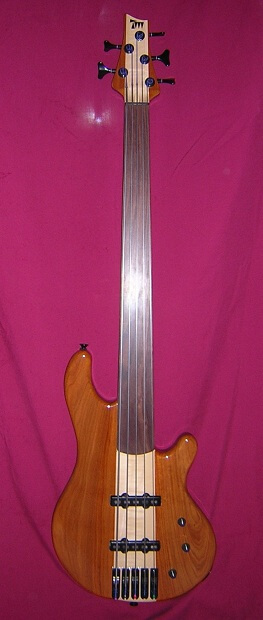This is the fourth bass I've built, and the second fretless. I decided on this instrument to do something subtle, understated and not ornate. I wanted a mellow, classy jazz machine.
Here are the specifications of the instrument:
Neck Type: Set neck
Neck Wood: Laminated maple, alternating grain direction.
Truss Rod: Dual action "Hot Rod"
Reinforcement: Two carbon fiber rods
Headstock: Fender-esque flat style (non-angled)
Tuners: Wilkinson
Nut: Graphite
Body Wood: South American Canarywood
Body Features: Forearm contour, rear belly cutaway.
Control Cavity: Grain matched
Fretboard: Rosewood, 10" to 20" compound radius
Scale Length: 35"
Pickups: Dimarzio Ultra Jazz 5
Controls: Two volume controls, single tone, push-pull switch on tone knob to switch pickups between parallel/series wiring.
Hardware: Black
Finish: Gloss nitrocellulose lacquer
Weight: Eight pound range (guesstimate)
Here is a straight on view of the front of the instrument. You can see there isn't much for decoration. The fingerboard is unlined and without any inlays. The wood isn't unusually figured or layered with decorative veneers. Clean and simple is what I was going for with this bass.

I really like the color of the canarywood. It has a grain that looks similar to mahogany, but a color that reminds me of cherry. The maple neck has a center section with a bit of tiger stripe in it, surrounded by two unfigured pieces.


Rather than a traditional solid bridge, I used five individual single string bridges. I did this both for the look, and to lighten the bass.

For the controls, I went with small rubber knobs. Again, this was primarily for weight reduction as the typical brass knobs weigh quite a bit.

It doesn't show well in the photograph, but there is a slight forearm contour on the left side of the body which increases the comfort of playing the instrument.

The headstock features my new 5-string bass design. To provide the proper string break angle over the nut, this instrument uses a flat recessed design similar to what Fender uses. The nut is made from graphite, which is an extremely low-friction material that increases tuning stability.

The tuners are from Wilkenson. You can see where I signed my name, numbered and dated the instrument. Because I shoot finish over this signature, the date is actually the date I sprayed the finish and not when I completed the entire instrument.

The back of the instrument features a recess that makes it more comfortable for those of us who are, er... "abdominally endowed."

The bass was finished with nitrocellulose lacquer, then sanded and buffed to turn it into a mirror. Unfortunately the pictures don't adequately capture how shiny the instrument is. You could comb your hair in the reflection if you like.

The cover for the electronics cavity is cut from a grain-matching piece of canarywood. This picture also gives a good view of the tiger striping on the center piece of maple used in the neck.

The neck is tapered at an angle all the way from the bottom of the body to the top of the neck. This is an unusual feature, and the first instrument I've built that features this type of construction.

I'm happy to report that I'm very pleased with the sound of this instrument. It has the traditional Fender Jazz "growl", but with the "mwah" of a fretless. The morning I took these pictures, my friend Trevor, virtuoso bassist from the band Showbaby, put the instrument through it's paces and I got a chance just to sit back and listen. I really think watching other people enjoy my instruments is more rewarding that playing them myself.


Check out the photos of this bass during construction.
Return To The Main Music Gallery
This page last updated on 06/28/2018



